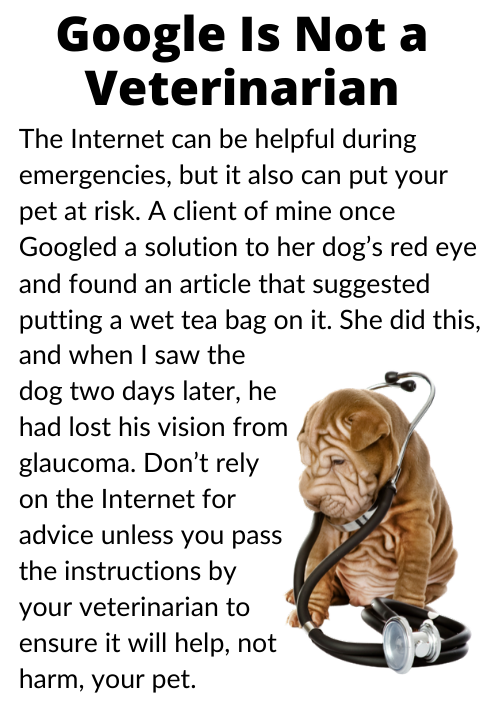
Owners often call into the veterinary clinic and ask if their pet’s illness or injury is an emergency or if it’s safe to observe him for a day. Of course, each dog and each situation is different, so if your pet is hurt or sick, calling your veterinarian for advice is always the best option. Most of the following warrants a trip to the veterinarian.
Inability to Stand
If your dog has fainted, collapsed, or is too weak to rise, he is screaming “take me to the vet.” It could be due to internal bleeding, a failing heart, a poisoning, an allergic reaction, or even low blood sugar—all of which need immediate treatment. Determining the problem can be hard, even for a veterinarian, and each problem is treated differently.
If your dog is suffering from paralysis, it could be from a fractured spine or a disk herniation, in which a disk is smashing the spinal cord. (Little dogs such as Dachshunds and Cocker Spaniels are at risk for this condition). If your dog has paralysis or is otherwise having difficulty moving, go for help right away.
Bleeding
If a dog loses enough blood, he can die, so in most cases, this is considered an emergency requiring immediate treatment. Arteries bleed faster and are more serious (you’ll see bright red blood pumping out if an artery has been punctured). If you see dark blood flowing out, it is likely a vein.
If your pet is bleeding, put pressure on the wound with a sterile pad or, in a pinch, a clean piece of clothing. Hold it on with your hand or wrap it with a bandage. Then, get to the hospital as soon as possible. Timing is everything, and quick treatment can mean the difference between life and death. I once treated a dog that had been run over by a train. He’d lost a leg and was bleeding profusely. The man who brought in the dog was a high school teacher of mine, who had managed to make a tourniquet using his belt and got the dog to the hospital.
Keep in mind that internal bleeding is less obvious and can be deadly. A dog hit by a car can bleed from his liver, and some dogs develop tumors that hemorrhage in the abdomen. Signs of internal bleeding are weakness and pale gums. Take your dog to the veterinarian immediately if you suspect he may have internal bleeding.
Seizures
Watching a dog have a seizure is truly terrifying. Though the violent muscle contractions look bad, the dog is, thankfully, oblivious to them when it happens. There are many causes of seizures, such as epilepsy, poisonings, liver shunts, brain tumors, and even infections. A single seizure is rarely a problem. If they continue one after another, it can cause overheating and even death. This is what I tell my clients: If your dog has a single seizure, protect him from harm and watch. If a second one comes along, then go immediately to the veterinary hospital in case a third one is coming on.
Vomiting/Diarrhea
The need for a veterinary visit depends on the severity of the condition. If your dog has just one episode of vomiting and feels good otherwise, he may need a few hours of stomach rest and a day or two of bland food to give the intestines a break. A diet of fish and sweet potato works well in this case. Seek veterinary care if you see blood in the vomit or stool or if the vomiting or diarrhea continues because it could lead to dehydration and may signal a more serious medical problem.

Pain
If a dog is crying, limping badly, or can’t be touched, he is sore. The trouble is that the dog can’t tell you how sore or what’s causing the pain, so it’s best to contact your veterinarian. If he can determine over the phone that the pain is mild and OK to treat at home, he may recommend a painkiller that is safe for dogs. Never give your dog medication, including over-the-counter meds, without first consulting with a veterinarian.
Bloat
Also called a torsion or gastric dilation-volvulus, this serious condition causes the stomach to swell and twist, impairing breathing and limiting blood flow. A dog with bloat needs immediate emergency care or he can die within hours. Signs of bloat include retching, swelling of the abdomen, restlessness, and weakness. If you see these signs, immediately take him to the nearest emergency vet.
Eyes Diseases and Injuries
If a dog has an eye problem, prompt treatment can mean the difference between losing sight and retaining vision. Always regard eye problems as an emergency.
If you’re ever in doubt if immediate care is needed, ask yourself this question: If your two-year-old child had the same symptoms, would you be on your way to the hospital? If the answer is “yes,” your dog should be seen immediately.
The AKC is here to help owners with questions and concerns about COVID-19 and dogs. Find answers to your questions, plus at-home activity ideas, training tips, educational resources, and more on our Coping With COVID-19 hub.
This article is intended solely as general guidance, and does not constitute health or other professional advice. Individual situations and applicable laws vary by jurisdiction, and you are encouraged to obtain appropriate advice from qualified professionals in the applicable jurisdictions. We make no representations or warranties concerning any course of action taken by any person following or otherwise using the information offered or provided in this article, including any such information associated with and provided in connection with third-party products, and we will not be liable for any direct, indirect, consequential, special, exemplary or other damages that may result, including but not limited to economic loss, injury, illness or death.


